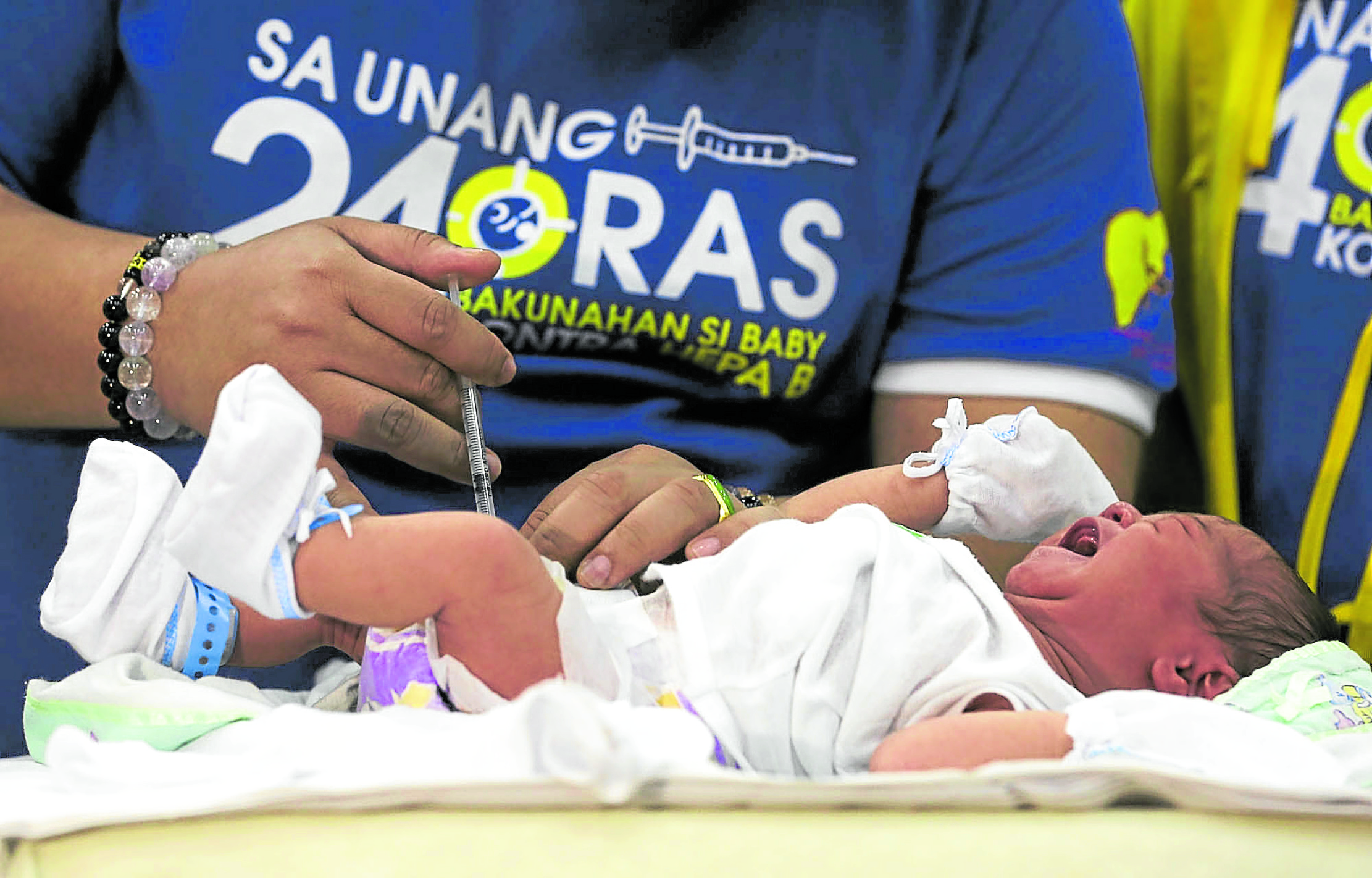PH among 10 nations that logged two-thirds of ‘hepa’ cases in 2022

CRUCIAL PROTECTION An infant is immunized against the hepatitis virus during a government drive in Quezon City in this 2016 file photo. NIÑO JESUS ORBETA
MANILA, Philippines — Amid the surge in measles and pertussis cases in the country, the World Health Organization (WHO) also sounded the alarm over the rising incidence of viral hepatitis, noting the low immunization rate among children against the vaccine-preventable disease.
In its 2024 Global Hepatitis Report released on Tuesday, the WHO said the Philippines, Bangladesh, China, Ethiopia, India, Indonesia, Nigeria, Pakistan, Russia and Vietnam, collectively accounted for nearly two-thirds of the “global burden” or worldwide cases of hepatitis B and C.
READ: Act against ‘silent killer’
New data from 187 countries showed that the number of deaths from viral hepatitis increased from an estimated 1.1 million in 2019 to 1.3 million in 2022. Of these, 83 percent were caused by hepatitis B, and 17 percent by hepatitis C.
About 3,500 people die worldwide per day from hepatitis viruses, 83 percent from hepatitis B and 17 percent from hepatitis C, the WHO said.
Article continues after this advertisementViral hepatitis is the second-biggest infectious killer, narrowly trailing tuberculosis.
Article continues after this advertisementREAD: One in seven Filipinos has ‘hyperendemic’ hepatitis B
‘Hyperendemic’
In the Philippines, there were a total of 6.1 million hepatitis cases—5.7 million hepatitis B, and 400,000 hepatitis C—that accounted for 2 percent of the worldwide infections in 2022.
A total of 1,045 Filipinos died due to viral hepatitis, or 0.2 percent of the 664,221 deaths recorded in 2022, based on data from the Philippine Statistics Authority.
Speaking at the Kapihan sa Manila Bay forum on Wednesday, Health Secretary Teodoro Herbosa attributed the high cases of hepatitis B in the country to the disease being “hyperendemic” in the Philippines, meaning any unvaccinated member of the population is highly susceptible to infection.
Herbosa also noted the low vaccination coverage against the blood-borne virus due to the lockdowns enforced during the coronavirus pandemic from 2020 to 2022.
According to Herbosa, the pentavalent (5-in-1) vaccine given to newborns for free in health centers offers protection against diphtheria, tetanus, pertussis, hepatitis B and Haemophilus influenzae type B.
However, many infants born during the pandemic were not given the lifesaving vaccines, a situation compounded by the spread of antivaccination content on social media.
This resulted in the Philippines becoming the fourth country in the world with the most number of children receiving “zero dose” of the three-shot pentavalent vaccine.
Still low at 71%
“Our vaccine coverage is only at 71 percent [of our around 2 million children age 1 year old and younger], which is really low. This low routine immunization coverage results in higher cases of these vaccine-preventable diseases,” the Department of Health (DOH) chief said.
“If we have achieved a 95-percent vaccination rate, our population would be protected and the hepatitis B cases will really go down. So I am again urging the parents to get your children vaccinated. Vaccines are safe and effective,” he added.
The DOH earlier said its supply of pentavalent vaccine doses was already running low following their redistribution in areas with pertussis outbreaks.
A new batch of 3 million doses of pentavalent vaccines won’t arrive in the country until June, it said.
Below global targets
The WHO said vaccination remained a cost-effective measure to prevent hepatitis B, with those immunized likely to be protected for at least 20 years.
The primary doses for hepatitis B are included under the National Immunization Program of the DOH.
Vaccine shots for hepatitis A are not provided by the government but may be purchased in private clinics and pharmacies for at least P3,000 a shot.
These are “alarming trends,” Meg Doherty, head of the WHO’s global HIV, hepatitis and sexually transmitted infection programs, said of the rise in hepatitis deaths.
There are effective and cheap generic drugs thatPH among 10 nations that logged two-thirds of ‘hepa’ cases in 2022 can treat these viruses, yet only 3 percent of those with chronic hepatitis B received antiviral treatment by the end of 2022, the report said.
For hepatitis C, just 20 percent—or 12.5 million people—had been treated.
“These results fall well below the global targets to treat 80 percent of all people living with chronic hep B and C by 2030,” Doherty said during a press conference in Geneva.
WHO chief Tedros Adhanom Ghebreyesus emphasized that the 2024 report “paints a troubling picture.”
“Despite progress globally in preventing hepatitis infections, deaths are rising because far too few people with hepatitis are being diagnosed and treated,” he said in a statement. —WITH A REPORT FROM AGENCE FRANCE-PRESSE